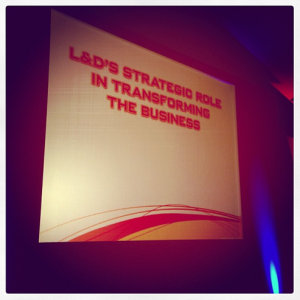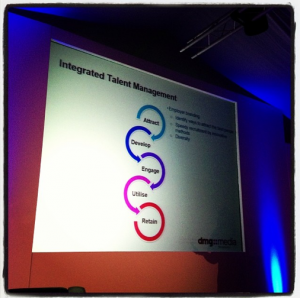The learning function was at the heart of logistics company DHL’s transformation which saved the company from going out of business.
According to Rick Jackson, head of the Certified International Specialist programme at DHL, the company was losing 2bn euros a year in 2008. Thanks to the L&D activities at DHL, that has been turned around and last year the company made 1bn euros in profit.
DHL’s challenge was to educate 100,000 people continuously across 220 countries.
 In order to do that, the company started from scratch with its engagement and L&D activities. It looked at how to transform the business and developed the Focus strategy which looked at: motivated people, great service quality, loyal customers, profitable network. The CIS programme – the name for the L&D initiative that would support the Focus strategy – was first rolled out in the US where the business was performing badly.
In order to do that, the company started from scratch with its engagement and L&D activities. It looked at how to transform the business and developed the Focus strategy which looked at: motivated people, great service quality, loyal customers, profitable network. The CIS programme – the name for the L&D initiative that would support the Focus strategy – was first rolled out in the US where the business was performing badly.
L&D as a function was removed from the HR function and put in the hands of Rick Jackson, who reported into the CEO. Jackson told delegates that this kind of transformation had to have the the support of senior leaders. In his case, the role of L&D was integral to the transformation of DHL and in the last two years the company has invested 150m euros in L&D.
With that money, Jackson has focused on:
- Content that had to be accepted by all cultures. There was a history of training programmes not converting across all cultures.
- Had to translate all materials into 41 languages
- The first programme had to be implemented within a year and facilitated by DHL.
- Building internal capability – there would be no external training providers coming into DHL and train our staff. We have 30 trainers and 1,200 facilitators to facilitate our programmes.
- Manage the process globally and locally. There are 160 people across the globe who control CIS locally. Guidelines developed centrally – all funded centrally and comms managed from the centre.
Video plays a big part in the learning content and DHL has developed a series of animations based on the Incredibles comic characters. ‘We don’t want boring Powerpoint slides in DHL training,’ Jackson said.
The company also uses a passport system as a way of unifying the workforce around the CIS brand. Each employee has a paper passport wit their picture, country stamps and achievement stickers.
There is also a big focus on DHL staff facilitating learning and training their peers. At a recent global meeting of the company’s top performers, a leadership programme was delivered by the top 120 employees. Jackson said the feedback from the event was ‘incredible’.
In their session on Gamification to engage and deliver results, David Butterfield, head of L&D, Aggregate Industries and Juliette Denny, MD, Growth Engineering, talked through how a traditional manufacturing company that makes building materials created an online academy to help professionalise the company’s sales team.
 Aggregate Industries employs 3,500 people across Europe and produces concrete and structural materials for big infrastructure projects such as the Olympic Park, Blackfriars Bridge station, The Shard, M1 widening and Terminal 5 at Heathrow.
Aggregate Industries employs 3,500 people across Europe and produces concrete and structural materials for big infrastructure projects such as the Olympic Park, Blackfriars Bridge station, The Shard, M1 widening and Terminal 5 at Heathrow.
The building industry has flatlined for years so motivating employees is that much harder. However, Butterfield told delegates that the organisation wanted to develop its sales people as it had traditionally developed its technical people.
The company developed a Commercial Excellence programme for sales people. It first looked at skills and behaviours expected in sales – skills to do the job and behaviours that back up the skills. Butterfield then mapped people against these skills and behaviours.
Of the 200 people involved in the process, 22% were where the company wanted them to be. Only 3% had the right skills but wrong behaviours. So, the challenge was how to provide long term development of skills for sales people. The answer was an learning academy that can be accessed all the time and that was verified by the (ISMM) Institute of Sales and Marketing Management – the professional body for the sales people.
The academy launched 18 months ago and by the end of this year all sales staff will be qualified. The approach is a blended one so in order to gain the diploma an employee has to compete four learning modules, one assignment per module and two one-day workshops.
Butterfield has also brought in coaches from the pharmaceutical industry to support sales managers to become better coaches in order to help embed learning from the academy.
Denny, who helped develop the academy, said game mechanics had helped the learning content to become more engaging. She said the key to success is not to tinker with a training program that doesn’t work and instead rethink how to do learning programmes with inbuilt game mechanics.
‘Gamification taps into reward, achievement, status, self-expression, competition. We do not need to create this, this is the human condition – we need to tap into it,’ she said.
The lunchtime panel debate on the future of learning provided some good news for L&D professionals. Because organisations are struggling to manage change, talent and the fast-changing technology landscape, there is a huge opportunity for L&D to step in and help deliver on these business needs.
Laura Overton, MD of Towards Maturity, said that the Towards Maturity benchmark shows L&D is struggling at connecting with the business.
 ‘The future of L&D is for those who are willing to have those conversations. There is an opportunity now – we have to manage change, talent and technology and manage it quickly. The future can belong to us. We need to be asking business, “How can I help you?”‘
‘The future of L&D is for those who are willing to have those conversations. There is an opportunity now – we have to manage change, talent and technology and manage it quickly. The future can belong to us. We need to be asking business, “How can I help you?”‘
Consultant Tim Neil told delegates that training used to be a process and in the last 5 years we have seen a shift to learning. It is now something that someone wants to do to get in their job, he said.
The role of L&D in the future is to help employees become experts. Analyse the skills that an expert has, and what they need to do and what content they need. Then make sure you deliver that.
Niall Gavin, head of HR and learning technologies at First Group hoped there would be more collaboration between L&D professionals and organisations. He said that because many companies produce compliance training that is fairly generic the industry should collaborate to share this content.
‘Why are we all designing and developing the same stuff. We do not collaborate enough outside of our organisational silos. This does not need to be inside any firewall.’
Gavin also suggested that companies should take away their training calendars and see what happens – raising the question of what is actually needed from L&D versus what the business actually requires.
A delegate asked whether new technologies require new pedagogies. Gavin said that technology does frame delivery and L&D professionals need to be aware of that. Overton said that simply using new technologies to do the same old things might drive some efficiencies but will not transform what you do.
Organisations need to understand how technology can transform L&D, she added.
Delivering continuous talent management
Catherine Rush, head of talent, dmg media, talked through her definition of integrated talent management and where L&D fits into this. She said the two are entwined. DMG owns brands such as the Daily Mail, Metro, Jobsite and is focused on building digital skills and capbabilities.
At DMG she wants to see a change of mindset and culture to shift from print to online and talent management is central to this. L&D is central to this because performance management is at the heart of talent management, she told delegates.
Aside form salary, organisations need to look at:
- The business – reputation in maker
- Role and working environment – responsibilities, culture, colleagues
- Leadership and management – behaviours, quality and style
- Personal development – growth od self, career opportunities
- Recognition and rewards
- Fit with domestic circumstances
When we think about talent management driving performance we need to bring our thinking up to date, Rush told delegates. She uses a model from Goddard and Eccles – in Uncommon sense, Common nonsense – that puts beliefs at the centre of your business. The belief system is what sets you apart in the market and you need to ask questions, have ideas and experiment – all of which feeds into the belief system.
Talent management needs to be thought of a motivator for productivity, she said.
Integrated talent management
To attract people never underestimate referrals. Use innovative methods and be speedy. L&D can start to foster long term relationships with universities to attract more grads. Rush warned that people will walk away from organisations if they are not being developed.
 Rush talked through the integrated talent management strategy she uses at DMG (pictured) and said that she works closely with colleagues to make it a reality. ‘I can influence managers ti make this work. My networking influence can help show that this model can work.’
Rush talked through the integrated talent management strategy she uses at DMG (pictured) and said that she works closely with colleagues to make it a reality. ‘I can influence managers ti make this work. My networking influence can help show that this model can work.’
Key success factor in the model is utilise – these people to help develop the business – make the most of the organisations. We should be creating new opportunities for people. Leading teams, etc job growth and enrichment. Find out what motivates people to stay – and tap into that. AT DMG CSR has worked really well, she said.
Rush gave these tips on enhancing the learning experience:
- Have a mix – keep open environments
- Location – dare to be different.
- Delivery, tell stories, eclectic mix of experiences, visual timings. Allow for reflection and networking
- Make it stick – what stops people
She added that reflection and networking is critical and that ownership for change is by the individual.




